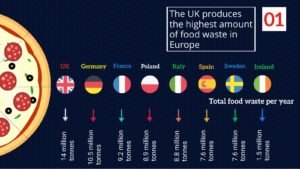Plastic packaging is no solution for food waste
 5 September 2019
5 September 2019
Food waste remains an acute problem in Europe and across much of the world. So does plastic waste. But what if the use of plastic in food wrapping could solve, or at least alleviate, the problem of food waste? By keeping food fresh longer, the thinking goes, plastic packaging can help consumers waste less food.
Except that it hasn’t worked. Food waste within the 28 nations of the European Union remains an acute problem. In fact, it’s got worse. In the decade between 2004 and 2014 food waste per person doubled even as the amount of plastic packaging in food products rose by up to 50%.
In 2015 alone, the costs of food waste within the EU amounted to a staggering €143 billion. That is equivalent to the operational budget of the economic grouping.
“Plastic packaging is often heralded as a means of avoiding food waste but it has not provided a comprehensive solution,” explain the authors of a recent study Unwrapped: How Throwaway Plastic is Failing to Solve Europe’s Food Waste Problem. “Growth in the application of plastic packaging has increased alongside the growth in food waste, with Europe’s total demand for plastic rising to 49 million tonnes per year, of which 40% is used for packaging.”

Even though plastic packaging can indeed make food stay fresh longer, it also stimulates environmentally harmful consumer behavior by enticing people to stock up on more food, much of which then gets wasted in the end.
To make matters worse, a lot of packaging currently in use is difficult to recycle so it ends up in landfills or as litter on streets.
And the problem is bound to get worse before it gets better. By next year people on the continent will likely consume more than 900 billion items of packaged food and drink each year, according to estimates. “[M]any packaging practices used by the food industry and retailers (e.g. multipacks) are implemented to support economic efficiencies and marketing and brand objectives rather than to preserve food,” the study’s authors argue.
“These practices can drive food waste throughout the value chain. For many products, zero or reusable packaging represents a viable and sustainable solution, and this is reflected in the growing number of retailers focusing on reducing the use of unsustainable packaging,” they add.
Considering the scale of the problem, there are no easy solutions. A variety of measures, however, would go a long way towards alleviating matters. The experts recommend that the EU should set targets for reducing the amounts of single-use packaging while simultaneously making more food packaging easily recyclable throughout the supply chain.
Among other measures, the experts also recommend supporting zero-waste initiatives and creating an right for customers across the EU to return any plastic packaging to the point of sale so that more of it can then be directly recycled.
The post Plastic packaging is no solution for food waste appeared first on Sustainability Times.
